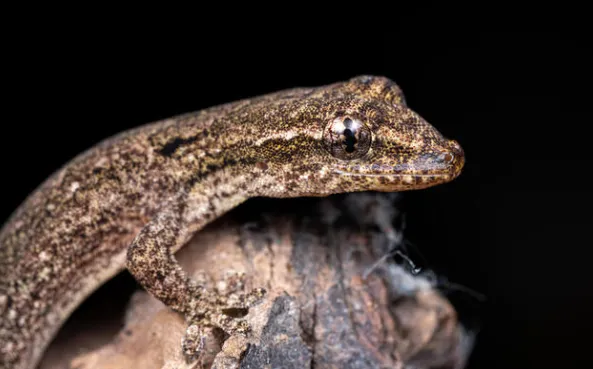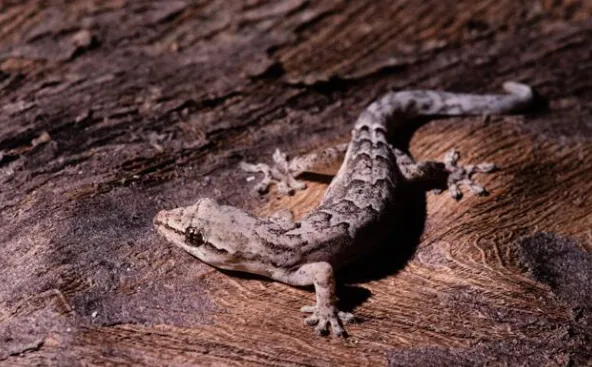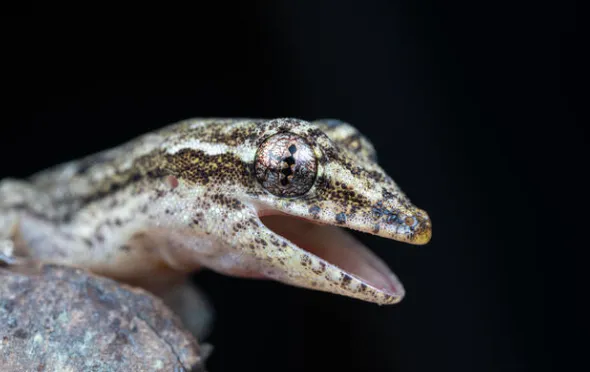
Table of Contents
Diet
Q: What do mourning geckos eat?
A: Mourning geckos primarily eat a diet of small insects such as fruit flies, pinhead crickets, and tiny mealworms. They can also consume commercial crested gecko diet, which offers a balanced nutrition.
Q: How often should I feed my mourning gecko?
A: Juvenile mourning geckos should be fed daily, while adults can be fed every other day.
Q: Can mourning geckos eat fruit?
A: Yes, mourning geckos can eat fruit, especially when mashed or provided in a puree form. Common choices include papaya, mango, and banana.
Q: Do mourning geckos eat live insects?
A: Absolutely. Live insects are an essential part of their diet, providing essential nutrients and proteins.
Q: What types of insects are safe for mourning geckos?
A: Safe insects include fruit flies, pinhead crickets, and tiny mealworms. Always ensure they’re appropriately sized for the gecko.
Q: Are there commercial diets available for mourning geckos?
A: Yes, there are commercial diets like the crested gecko diet which is often used and is suitable for mourning geckos.
Q: Do mourning geckos need supplements?
A: It’s advisable to dust the insects with a calcium supplement without D3, especially if you’re not using UVB lighting. A multivitamin supplement can also be provided once a week.
Q: How can I ensure the
A: Feed them a varied diet, gut-load the insects before feeding, and provide supplements. Also, make sure any fruit or commercial
Q: Can mourning geckos eat baby
A: While they can consume baby
Q: Is calcium important in a mourning gecko’s diet?
A: Yes, calcium is crucial for bone health, especially for females that lay eggs.
Q: What are signs of a poor diet in mourning geckos?
A: Weight loss, lethargy, soft bones or difficulty moving, and issues with shedding are potential signs of dietary issues.
Q: Can mourning geckos eat vegetables?
A: Mourning geckos usually show little interest in vegetables. Their primary diet should be insects and fruits.
Q: Do mourning geckos drink water?
A: Yes, they will drink water droplets from misting or from leaves in their habitat.
Q: How to gut-load insects before feeding them to mourning geckos?
A: Gut-loading involves feeding nutritious foods to the insects for at least 24 hours before offering them to your gecko. Feed the insects a mix of grains, fruits, and vegetables.
Q: Are there any foods that are toxic or harmful to mourning geckos?
A: Avoid feeding them insects caught from the wild, as they might contain pesticides. Also, refrain from feeding them avocados, chocolate, and any

Habitat
Q: What type of enclosure is best for mourning geckos?
A: Mourning geckos thrive in glass terrariums that allow for vertical climbing space. Vertical enclosures with front-opening doors are preferred as they facilitate easy access and maintenance.
Q: How big should a mourning gecko’s habitat be?
A: For a single mourning gecko, a 12x12x18 inch enclosure is suitable. However, if housing multiple geckos, a larger space will be required to reduce territorial disputes.
Q: What is the ideal temperature for mourning geckos?
A: The daytime temperature should be between 75-80°F, and at night it can drop to about 70°F. Providing a temperature gradient (warmer and cooler areas) within the enclosure is important.
Q: Do mourning geckos need UVB lighting?
A: While mourning geckos can survive without UVB lighting, providing it can improve their overall health and well-being.
Q: What kind of substrate works best for mourning geckos?
A: A mix of coconut coir, sphagnum moss, and orchid bark works well. This substrate retains humidity and mimics their natural environment.
Q: How often should I clean the mourning gecko’s enclosure?
A: Spot cleaning should be done regularly to remove feces and uneaten
Q: How do I maintain humidity in a mourning gecko habitat?
A: Mist the enclosure daily, ensuring it has a chance to dry out between mistings. Using live plants and a proper substrate can also help maintain humidity.
Q: What plants are safe for mourning gecko enclosures?
A: Pothos, bromeliads, and snake plants are popular choices. They not only help maintain humidity but also provide climbing and hiding spaces.
Q: Can multiple mourning geckos be housed together?
A: Yes, mourning geckos are communal and can be housed together. However, monitor for signs of aggression and ensure the enclosure is spacious enough to reduce territorial disputes.
Q: What’s the difference between male and female mourning gecko habitats?
A: Interestingly, mourning geckos are parthenogenetic, meaning all individuals are females and reproduce without mating. Therefore, there isn’t a distinct difference in habitats based on gender.
Q: How do I set up a vertical space for climbing in a mourning gecko’s terrarium?
A: Provide vertical structures like cork bark, branches, and plants. Mesh or foam backgrounds also offer additional climbing surfaces.
Q: What type of hides or decorations are best for mourning geckos?
A: Cork bark, hollow bamboo pieces, and leafy plants provide good hiding spots. The aim is to mimic their natural environment.
Q: Do mourning geckos require a water dish?
A: While they primarily get their water from droplets after misting, a shallow water dish can also be provided.
Q: How to mimic the mourning gecko’s natural habitat?
A: Incorporate live plants, varied substrates, and climbing structures. Maintain high humidity and provide a day-night temperature gradient to closely resemble their native habitat.
Q: Are there specific materials or plants to avoid in a mourning gecko’s habitat?
A: Avoid using sand or gravel as substrate. Toxic plants like poinsettias and ivies should be avoided. Also, ensure that any decorations don’t have sharp edges that can harm the geckos.

Behavior
Mourning Gecko Behavior Q&A
Q: Why is my mourning gecko chirping at night?
A: Mourning geckos are known to produce chirping sounds, especially during the nighttime. This chirping is a form of communication, often related to mating calls, territorial disputes, or interactions between geckos.
Q: How do mourning geckos communicate with each other?
A: Mourning geckos communicate primarily through vocalizations like chirping and body language such as tail waving, posturing, and color displays.
Q: Are mourning geckos nocturnal?
A: Yes, mourning geckos are primarily nocturnal, meaning they are most active during the night.
Q: Do mourning geckos like to be handled?
A: Generally, mourning geckos are not fond of handling and can be quite skittish. It’s best to limit handling to reduce stress for the gecko.
Q: How can I tell if my mourning gecko is stressed?
A: Signs of stress in mourning geckos include excessive hiding, refusal to eat, rapid breathing, and persistent attempts to escape the enclosure.
Q: Why is my mourning gecko always hiding?
A: Mourning geckos are naturally secretive creatures and prefer to have hiding spots. Consistent hiding can also be a sign of stress or discomfort.
Q: Can mourning geckos be kept together in the same enclosure?
A: Yes, mourning geckos are communal and can be kept together. However, it’s crucial to monitor for any signs of aggression and ensure the enclosure is spacious with multiple hiding spots.
Q: Is it normal for mourning geckos to drop their tails?
A: Like many geckos, mourning geckos have a defense mechanism called ‘autotomy,’ where they can drop their tails to distract predators. While it’s a natural behavior, frequent tail dropping can indicate stress or frequent disturbances.
Q: Why does my mourning gecko keep climbing the walls of its enclosure?
A: Mourning geckos are arboreal, meaning they like to climb. It’s natural for them to explore vertical spaces.
Q: How active should mourning geckos be?
A: Mourning geckos are most active during the night. You’ll notice them exploring, hunting, and interacting during these hours.
Q: What does it mean when a mourning gecko licks its surroundings?
A: Geckos often lick their surroundings to gather information about their environment, tasting for possible
Q: Are mourning geckos territorial?
A: While they can be housed communally, they can show territorial behaviors, especially during breeding seasons.
Q: Why won’t my mourning gecko eat?
A: Refusal to eat can be due to various reasons, including stress, unsuitable temperatures, illness, or shedding.
Q: How can I encourage natural behaviors in my mourning gecko’s enclosure?
A: Ensure the habitat replicates their natural environment. Provide climbing structures, hiding spots, and varied foods.
Q: Do mourning geckos recognize their owners?
A: While they might become familiar with the presence of their keepers, it’s unlikely they recognize owners in the same way mammals might.
Q: Why is my mourning gecko always near the top of its enclosure?
A: Mourning geckos are arboreal, so they naturally prefer being higher up. Ensure they have adequate vertical space and climbing structures.
Q: Do mourning geckos vocalize often?
A: Yes, especially during the nighttime or breeding seasons. They use chirps and calls to communicate.
Q: Can I house mourning geckos with other species of geckos?
A: It’s generally not recommended. Different species have varied requirements and may display aggressive behaviors towards one another.
Q: Why does my mourning gecko seem restless?
A: Restlessness can be due to various factors, including the need for a larger enclosure, unsuitable temperatures, or underlying health issues.
Q: How can I tell the difference between male and female mourning geckos?
A: Interestingly, mourning geckos are parthenogenetic, meaning most populations consist entirely of females that reproduce without males. They lay unfertilized eggs that hatch into clones of the mother. In most cases, identifying a “male” isn’t applicable.

Health and Wellness
Q: How can I tell if my mourning gecko is sick?
A: Sick mourning geckos often exhibit symptoms like lethargy, lack of appetite, irregular breathing, discolored skin, or a swollen abdomen. It’s crucial to monitor your gecko’s behavior and appearance regularly to catch any abnormalities early on.
Q: Why isn’t my mourning gecko eating?
A: Lack of appetite can be due to stress, incorrect habitat conditions, illness, or shedding. Ensure the temperature and humidity levels are right, and the gecko feels safe in its environment.
Q: What are the signs of dehydration in mourning geckos?
A: Wrinkled or saggy skin, sunken eyes, and lethargy are common signs. Ensure they have access to fresh water and mist their enclosure regularly.
Q: How often should mourning geckos shed their skin?
A: Juvenile geckos shed more frequently, sometimes every few weeks, while adults may shed once a month or less. Regular shedding is a sign of healthy growth.
Q: Do mourning geckos require any specific supplements?
A: Yes, like many reptiles, they benefit from calcium and vitamin D3 supplements to support bone health and prevent metabolic bone disease.
Q: What are common parasites in mourning geckos, and how do I treat them?
A: Internal parasites like pinworms can affect mourning geckos. If you suspect a parasitic infection, consult a veterinarian. They’ll likely recommend fecal tests and appropriate medication.
Q: Why is my mourning gecko losing its tail?
A: Geckos might drop their tails as a defense mechanism when threatened. It can also occur due to stress, illness, or injury. The tail will regrow, but it won’t look the same as the original.
Q: Can mourning geckos develop respiratory infections?
A: Yes. Symptoms include difficulty breathing, mucus around the nose/mouth, and lethargy. Consult a vet immediately if you suspect a respiratory infection.
Q: What is the ideal humidity level for mourning geckos?
A: Mourning geckos thrive in 60-80% humidity. Misting the enclosure helps maintain this level.
Q: Why is my mourning gecko’s skin looking discolored or patchy?
A: This could be due to an upcoming shed, injury, skin infection, or other health issues. Monitor the gecko and consult a vet if concerned.
Q: How can I tell if my mourning gecko is stressed?
A: Signs include erratic behavior, lack of appetite, excessive hiding, or aggressive reactions when approached.
Q: What are the signs of metabolic bone disease in mourning geckos?
A: Weakness, softened or deformed bones, tremors, and difficulty moving are indicative signs. Ensuring proper calcium and vitamin D3 intake can prevent this condition.
Q: How do I treat cuts or wounds on my mourning gecko?
A: Clean the wound with a mild antiseptic and consult a vet for further treatment.
Q: Why is my mourning gecko acting lethargic?
A: Lethargy can be due to illness, stress, incorrect habitat conditions, or it might just be the gecko’s natural behavior during its inactive period.
Q: Are there any specific foods that are toxic to mourning geckos?
A: Mourning geckos should avoid avocado, chocolate, and any insecticides or pesticides on their
Q: How often should I bring my mourning gecko to the vet?
A: Annual check-ups are recommended. However, if you notice any signs of illness or abnormal behavior, consult a vet immediately.
Q: How do I ensure my mourning gecko’s enclosure is safe and free from hazards?
A: Regularly inspect the enclosure for sharp objects, ensure all equipment is functioning correctly, and keep the habitat clean.
Q: Can mourning geckos get mites or fungal infections?
A: Yes. If you notice small bugs on your gecko or discolored patches on their skin, it may be mites or a fungal infection. Consult a vet for treatment.
Q: What kind of substrate is safest for mourning geckos?
A: Paper towels, reptile carpet, or coco fiber are commonly used. Avoid sand or loose substrate to prevent ingestion.
Q: Why does my mourning gecko have a swollen or bloated belly?
A: It could indicate impaction, parasites, or other internal issues. If the swelling doesn’t resolve or if it’s accompanied by other symptoms, consult a veterinarian.
- Enchi Ball Python: A Unique and Stunning Morph of Python regius - March 27, 2025
- Emerald Tree Monitor: The Enigmatic Green Guardian of the Rainforest - March 26, 2025
- The Egyptian Cobra (Naja haje): A Fascinating Serpent - March 25, 2025
